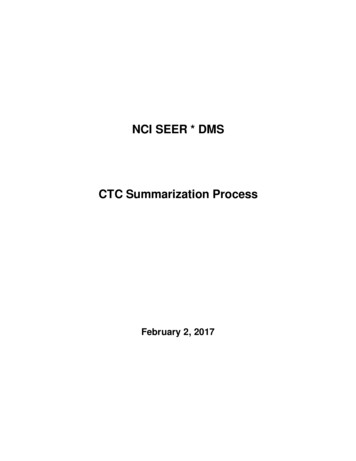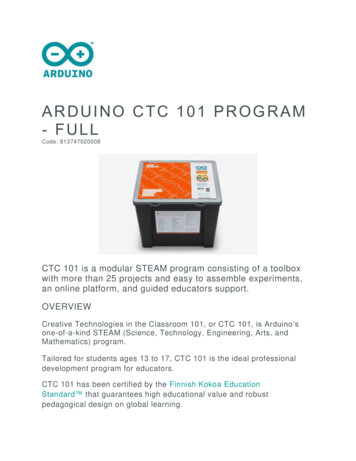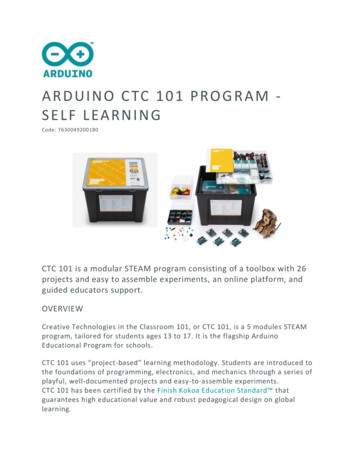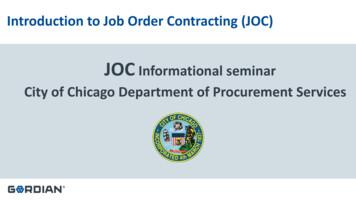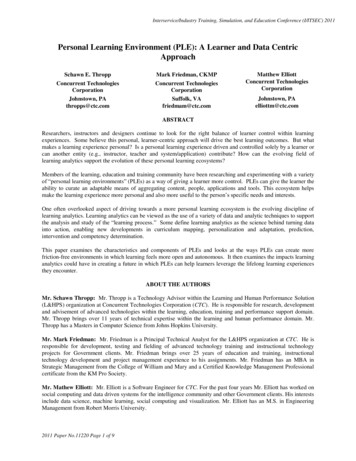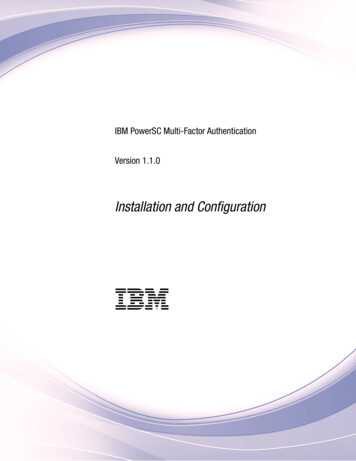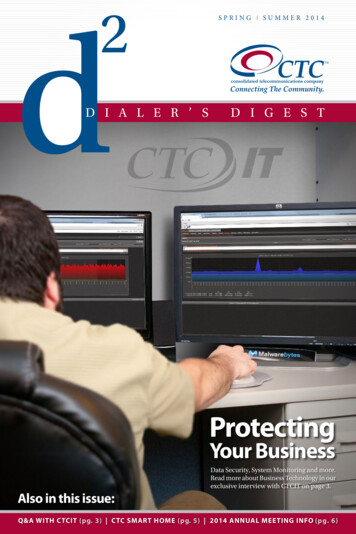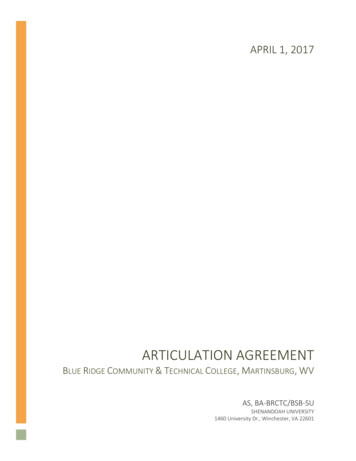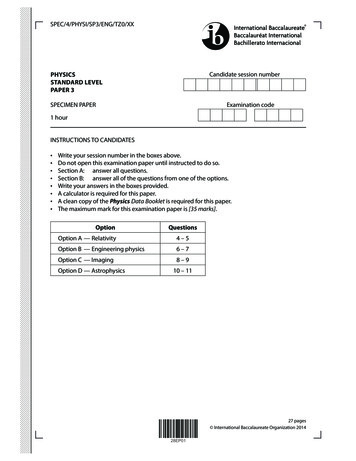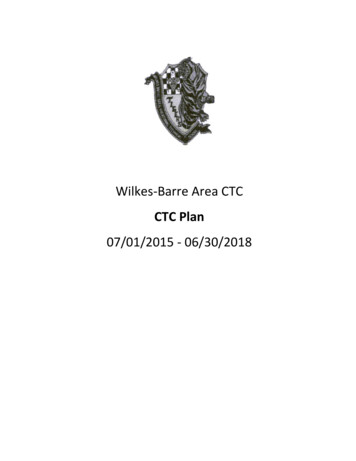
Transcription
Wilkes-Barre Area CTCCTC Plan07/01/2015 - 06/30/2018
2CTC ProfileDemographicsPO Box 1699Wilkes-Barre, PA 18705(570)822-4131AYP Status: NoneExecutive Director: Peter HaleseyPlanning ProcessWilkes-Barre Area CTC is excited about the opportunity to improve the educational environmentdelivered at our Career and Technical Center. To that end, we have formed committees to design,implement, and maintain a high performing educational system. As the Project Leader, I met with my CPTeam to discuss the nine characteristics of high performing educational systems. We agreed to continueto visit on each of these nine components and evaluate throughout this CP process. In addition, wediscussed incorporating 21st Century Skills into the CTC Plan as outlined in the CP CTC Planning offlineguidance tool.Wilkes-Barre Area CTC will utilize the following CP Administrative Team throughout the CP CTC planningprocess through the 6 CTC Planning components.The CP Administrative Team will break into six (6) subgroups. Each subgroup will report to Tony Guarigliaon each of the six (6) areas. The six subgroups are: Profile, Core Foundations, Assurances, NeedsAssessment, Action Planning, and Plan Submission.The meeting schedule will be on a rotating basis according to our school calander and will commence atthe proper planning stage, as outlined on page 6 of the revised (3/19/13) CTC Planning-Offine GuidanceTool. Each subcommittee will meet from 2:40 - 3:00 pm once a week. Every week the entire committeewill meet on Tuesday morning from 7:45 - 8:15 to sustain momentum and adhear to our timeline.Tony Guariglia, PhD, Project Leader, is responsible to keep communication lines open between allmembers. We will use e-mail and phone for communications which need to occur between meetingtimes. Each member will be cc'ed on all communications within their subcommittee.The completed plan will be on display at the Wilkes-Barre Area Career and Technical Center's main officefor 28 days. At the completion of the 28 days, the WBACTC Comprehensive Plan will be approved by theJoint Operating Committee at the following meeting.
3Mission StatementThe mission of the Wilkes-Barre Area Career and Technical Center, partnering with itssponsoring districts, community, parents, and students, is to contribute to a high qualitycareer/technical and academic education for its students who, upon completion, are able tobecome responsible citizens, critical thinkers, and successful completers in a world-wideeconomy, and possess the desire and skills to be life-long learners.Vision StatementVision StatementThe Wilkes-Barre Area Career and Technical Center, through its programs of study and dedicated andexperienced Instructors, administrators, and staff, will serve as a leading educational institution andcommunity resource for all citizens seeking to explore, develop, and enhance their career and technicalskills in a nurturing and supportive enviornment.Shared ValuesThe shared value statements were developed by the members of the CP planning committee. Below is acompilation of what each committee member felt were foundational to a quality education at the WilkesBarre Area Career and Technical Center:We believe that education received through school provides the foundation for life-long learning.We believe that every student has a right to the opportunity to learn and succeed.We believe that schools must enrich the economic life of the community.We believe that schools must help students prepare to be a positive part of the community's economiclife.We believe that access to technology is a part of the opportunity to learn.We believe that quality schools foster effective communication.We believe that students must develop critical thinking skills.We believe in respecting our students' diverse backgrounds, abilities, interests, and needs.We believe students must be treated as individual learners.
4We believe that, along with the school, parents share in the responsibility for the students' educationalsuccess.Educational CommunityWilkes-Barre Area Career & Technical CenterDemographical Data ReportSchool Year 2013-2014Student PopulationTotal Students: 880Total Male Students: 548Percentage of Male Students: 63%Total Female Students: 332Percentage of Female Students: 37%Total IEP’s: 342Percentage of Students with IEP’s: 39%Total Black Students: 91Black Student IEP: 46Percentage Black Students: 10%Percentage Black Student IEP: 13%Total Asian Students: 2Asian Student IEP: 1Percentage Asian Students: 1%Percentage Asian Student IEP: 1%
5Total White Students: 716White Student IEP: 267Percentage White Students: 81%Percentage White Student EIP: 78%Total Spanish Students: 62Spanish Student IEP: 25Percentage Spanish Students: 7%Percentage Spanish Student IEP: 7%Free and Reduced LunchTotal Students: 880Total Receiving Free Lunch: 501Percentage Receiving Free Lunch: 57%Total Receiving Reduced Lunch: 68Percentage Receiving Reduced Lunch: 8%Student Achievement DataTotal Graduates: 153Total Completers: 122Percentage of Completers: 80%Number of IEP Completers: 51Percentage of IEP Completers: 33%
6Total ESL Completers: 3Percentage of ESL Completers: 2%Total Non-Traditional Completers: 3Percentage of Non-Traditional Completers: 2%Total Completers: 122Total Advanced Completers: 68Percentage Advanced Completers: 56%Total Basic Completers: 20Percentage Basic Completers: 16%Total Competent Completers: 34Percentage Competent Completers: 28%IEP Completer DataTotal IEP Completers: 51Total IEP Advanced Completers: 26Percentage IEP Advanced Completers: 51%Total IEP Basic Completers: 11Percentage IEP Basic Completers: 22%Total IEP Competent Completers: 14Percentage IEP Competent Completers: 27%ESL Completer Data
7Total ESL Completers: 3Total ESL Advanced Completers: 1Percentage of ESL Advanced Completers: 34%Total ESL Basic Completers: 0Percentage of ESL Basic Completers: 0%Total ESL Competent Completers: 2Percentage of ESL Competent Completers: 66%Non Traditional Completer DataTotal Non-Traditional Completers: 3Total Advanced Non-Traditional Completers: 1Percentage of Advanced Non-Traditional Completers: 34%Total Basic Non-Traditional Completers: 0Percentage of Non-Traditional Completers: 0%Total Competent Non-Traditional Completers: 2Percentage of Competent Non-Traditional Completers: 66%Planning CommitteeNameAllison BanksAmy BradyMichelle Egidio-OkoDr. Tony GuarigliaCindi HeyenDavid JoyceJill KingRoleSecondary School Teacher - Special EducationBusiness RepresentativeBusiness RepresentativeAdministratorParentSecondary School Teacher - Regular EducationSecondary School Teacher - Special Education
8Mr. Bruce KnickJohn KozerskiMr. Joe LakkisAmy PattonJoseph SalvoJennifer ScullChris ShraderTony TestaHayden WhiteCommunity RepresentativeEd Specialist - School CounselorSecondary School Teacher - Regular EducationSecondary School Teacher - Regular EducationCommunity RepresentativeParentSecondary School Teacher - Regular EducationAdministratorEd Specialist - School Counselor
9Core FoundationsStandardsMapping and AlignmentStandardsArts and HumanitiesCareer Education and WorkCivics and GovernmentCommon Core Standards: English Language ArtsCommon Core Standards: Literacy in History/SocialStudies, Science and Technical SubjectsCommon Core Standards: MathematicsEconomicsEnvironment and EcologyFamily and Consumer SciencesGeographyHealth, Safety and Physical EducationHistoryScience and Technology and Engineering tion for standard areas checked "Needs Improvement" or "Non Existent":This narrative is empty.Adaptations Career Education and WorkCommon Core Standards: English Language ArtsCommon Core Standards: MathematicsFamily and Consumer SciencesScience and Technology and Engineering EducationExplanation for any standards checked:This narrative is empty.CurriculumPlanned InstructionCurriculum CharacteristicsStatus
10Objectives of planned courses, instructional units or interdisciplinarystudies to be achieved by all students are identified for each subject area.Content, including materials and activities and estimated instructionaltime to be devoted to achieving the academic standards are identified.The relationship between the objectives of a planned course,instructional unit or interdisciplinary studies and academic standardsare identified.Procedures for measurement of mastery of the objectives of a plannedcourse, instructional unit or interdisciplinary studies are identified.Processes used to ensure evelopingEach Program of Study Task List contain PACore, Reading, Writing, and Mathematics standards.Each Program of Study holds the student to this requirement as well as any and all associatedIndustry Certifications associated with a specific Program of Study.Many Programs of Student (I.E. Cosmetology) demand a specific number of minimum hours toachieve "Completer" status. WBACTC holds those students on those Programs of Studyaccountable to those hours.Explanation for any standards areas checked "Needs Improvement" or "Non Existent". How theLEA plans to address their incorporation:This narrative is empty.Modification and AccommodationsExplain how planned instruction contains modifications and accommodations that allow allstudents at all mental and physical ability levels to access and master a rigorous standardsaligned curriculum.The Pennsylvania Department of Education Program of Study Task List is used to track eachstudent through their CTC experience. For those students with an IEP, the instructor follows theinstructions on the accommodation sheets within the approved IEP for each student. Eachstudent is made aware of the expectations necessary to achieve success in their specificprogram of study and within that program of study, the level of expectation in the lab.The Program of Study Instructor is responsible to communicate to students, parents, andadministration, if a student is identified as not meeting any expected task on that task list forany reason, including IEP. Appropriate meetings follow and additional accommodations or otheroptions are identified.Instruction
11Instructional Strategies Formal classroom observations focused on instructionWalkthroughs targeted on instructionAnnual Instructional evaluationsPeer evaluation/coachingInstructional CoachingRegular Lesson Plan Review Administrators Instructional CoachesProvide brief explanation of LEA's process for incorporating selected strategies.The Since Pennsylvania adopted the Charlotte Danielson framework for teaching as theevaluation tool to be used, the Wilkes-Barre Area CTC has, in turn, trained its Administration tounderstand and effectively implement this model. According to state law, the 2013-2014 schoolyear was the starting point for the realization of this new evaluation. As a result theadministration evaluated each Instructor according to this model. Because of thecomprehensive approach to this model, the Instructors planning and preparation, classroomenvironment, actual instruction, and professional responsibilities were reviewed and assessed.The following strategies were applied to ensure standards aligned instruction and consistencybetween classrooms; grades; subjects; and/or programs existed. The Danielson model allowedthe administration to document formal classroom observations focused on a preordainedinstruction expectation. The administration has walked through each Instructional area, focusingspecifically on instruction. This resulted in the annual Instructional evaluations targeted on selfexploration, self-reflection, and self-improvement by each Instructor. This includes evaluation ofthe appropriate certification exams - including NOCTI.Peer evaluation and coaching is accomplished by each new Instructor being provided a mentorteacher to help the new teacher assimilate into the classroom. Each new teacher is alsomandated to complete the New Teacher Induction Program as approved by the Joint OperatingCommittee. Peer evaluation / coaching is also implemented and suggested on a case by casebasis by the administration as the administration observes or becomes aware that a gap in theInstructional model is present and needs to be bridged. Existing teachers are utilized throughpeer evaluation and coaching to help with identified gaps in the Instructional process.The Wilkes-Barre Area CTC utilizes the administration of WBACTC and the Luzerne IntermediateUnit #18 as Instructional coaches to help the classroom Instructors with curriculum alignmentand other needs, such as 30 Hours of small group iPad training during the 2013-2014 schoolyear.The Wilkes-Barre Area CTC utilizes the administration of WBACTC and the Luzerne IntermediateUnit #18 as Instructional coaches to assist in the Regular Lesson Plan Review; which is donethrough both the Danielson model and through our ongoing 339 review of each InstructorProgram of Study.Provide brief explanation for strategies not selected and how the LEA plans to address theirincorporation.WBACTC does not have "Cluster Chairs". The WBACTC does ask vetran teachers to sit on variouscommittees dedicated to Instructional Study. However, as of today, Career Cluster Chairs are
12being considered by the Joint Operating Committee. As WBACTC continues to grow and expand,the need for Cluster Chairs and Chairs of Programs of Study with more than one instructorbecomes increasingly necessary to assure proper accountability and consistency of the POS.Responsiveness to Student NeedsInstructional PracticesStructured grouping practices are used to meet student needs.Flexible instructional time or other schedule-related practices are usedto meet student needs.Differentiated instruction is used to meet student needs.A variety of practices that may include structured grouping, flexiblescheduling and differentiated instruction are used to meet the needs ofgifted nFullImplementationFullImplementationIf necessary, provide further explanation. (Required explanation if column selected wasThe Joint Operating Committee added two Special Education Teachers to our staff here atWBACTC for this 2014-2015 school year. These additions allow 100% of our special and regulareducation population flexible instructional time and access to additional differentiatedinstruction in order to best meet the needs of each individual student.Recruitment(Comprehensive CTC only)Describe the process you implement to recruit and assign the most effective and highly qualifiedteachers in order to meet the learning needs of students who are below proficiency or are atrisk of not graduating.This narrative is empty.Describe the process the CTC implements to recruit and assign the most effective and qualifiedteachers based on their industry experience.The JOC has an approved vetting proceedure in place to help identify the most qualifiedcandidate for all open positions. Included in the process is an evaluation sheet which is thenaveraged with all other evaluations to produce the "recommended" candidate.AssessmentsLocal Graduation Requirements(Comprehensive CTC who graduate students only)
13Course Completion2015–20162016–20172017–2018Total CoursesCTE Specific ContentEnglishMathematicsSocial StudiesSciencePhysical EducationHealthMusic, Art, Family &Consumer Sciences,Career and TechnicalEducationElectivesMinimum % GradeRequired for Credit(Numerical Answer)Local Assessments(Comprehensive CTC who graduate students only)StandardsWATDNATArts and HumanitiesCareer Education and WorkCivics and GovernmentCommon Core Standards: EnglishLanguage ArtsCommon Core Standards: Literacyin History/Social Studies, Scienceand Technical SubjectsCommon Core Standards:MathematicsEconomicsEnvironment and EcologyFamily and Consumer SciencesGeographyHealth, Safety and PhysicalEducationHistoryScience and Technology andEngineering Education2015 and beyond Graduation Requirement SpecificsDAPSWOther
14(Comprehensive CTC who graduate students only)Identify the method(s) used for determining graduation proficiency for the following sets ofstandards. (Check all that apply)English Language ArtsNo methods have been identified for this standard.Algebra INo methods have been identified for this standard.BiologyNo methods have been identified for this standard.Methods and MeasuresSummative Assessments NOCTI Testing NIMS testingBenchmark Assessments Teacher specific benchmarks based on the Approved Task List for the Program of StudyFormative Assessments Think-Pair-Share Curriculum-Based Assessment (progress monitoring) Questioning strategiesDiagnostic Assessments SAS Classroom Assessment Teacher specific assessments based on the expected PA Core standards needed forsuccessValidation of Implemented Assessments(Comprehensive CTC only)No validation methods have been identified for this content area.Provide brief explanation of your process for reviewing assessments.This narrative is empty.Development and Validation of Local AssessmentsIf applicable, explain your procedures for developing locally administered assessments and howthey are independently and objectively validated every six years.
15WBACTC is currently adding Child Care Management and support Services Program of Study. Weare expecting to assign students to enter local facilities and work with Care providers. Theseemployers may have specific requirments which we will need to address before sending ourstudets. This has the potential of developing into a locally administred assessment. If it isnecessary WBACTC will address.Collection and DisseminationDescribe your system to collect, analyze and disseminate assessment data efficiently andeffectively for use by LEA leaders and instructional teams.The NOCTI and NIMS testing, as well as our many Industry Certification tests, are broken downand educational gaps are located and addressed. This information is compiled by the teachersand administration, then shared with the teacher and teacher groups to allow for differenciatedInstructional decisions and professional development opportinities to be created to bridge theeducational gaps identified. The entire process is shared and viewed by each POS's OccupationalAdvisory Committee and feedback is encouraged and gathered.Data Informed InstructionDescribe how information from the assessments is used to assist students who have notdemonstrated achievement of the academic standards at a proficient level or higher.In the same was as above, the NOCTI and NIMS testing, as well as our many IndustryCertification tests, are broken down and educational gaps are located and addressed. as above,this information is compiled by the teachers and administration, then shared with the teacherand teacher groups to allow for differentiated Instructional decisions and professionaldevelopment opportunities to be created to bridge the educational gaps identified. WBACTC hastwo Special Education Teachers on staff which addresses the needs of all of our students,especially those with an IEP. In addition, we have four academic instructors on staff. In additionto their teaching responsibilitites, they are required to work with students on a one-one and/orsmall group environment to help students bridge educational gaps identified through testing.Assessment Data Uses(Comprehensive CTC only)No assessment data uses have been identified for this content area.Provide brief explanation of the process for incorporating selected strategies.This narrative is empty.
16Provide brief explanation for strategies not selected and how you plan to address theirincorporation.This narrative is empty.Distribution of Summative Assessment Results Course Planning Guides Directing Public to the PDE & other Test-related Websites Individual Meetings Letters to Parents/Guardians Local Media Reports Website Meetings with Community, Families and School Board Mass Phone Calls/Emails/Letters Press Releases School Calendar Student HandbookProvide brief explanation of the process for incorporating selected strategies.WBACTC has a media relations position defined in the CBA, and held by a full time Instructor.They follow a proceedure to provide information to local media concerning communications. Inaddition, WBACTC does communicate with mass calling. The handbook contains information aswell as our website. Administration is accountable to provide a strong community presence.Provide brief explanation for strategies not selected and how the LEA plans to address theirincorporation.WBACTC has a form of newsletter on our website but does not currently have any plans for apaper version at this time.Safe and Supportive SchoolsPrograms, Strategies and Actions
17 Biennially Updated and Executed Memorandum of Understanding with Local LawEnforcement Conflict Resolution or Dispute Management Peer Helper Programs Safety and Violence Prevention Curricula Student Codes of Conduct Comprehensive School Safety and Violence Prevention Plans Purchase of Security-related Technology Student, Staff and Visitor Identification Systems Placement of School Resource Officers Student Assistance Program Teams and Training Counseling Services Available for all Students Internet Web-based System for the Management of Student Discipline Coordination of Services with Sending SchoolExplanation of strategies not selected and how the LEA plans to address their incorporation:In order to best address the of barriers to student learning, which include bullying, child abuse/neglect,cultural diversity, divorce/ blended families, drug and alcohol use/abuse, English language learning, familyissues, grief and loss, homelessness, immigration status, low socioeconomic status, mental health issues,military deployment, physical illness, poor nutrition, relocation, sporadic parental involvement, teenpregnancy/parenting, unemployment of parent/guardian and being a victim or witness to violence, WilkesBarre Area CTC has been addressing each of these issues with direct programs and dedicated staff andfacultyIn regard to schoolwide positive behavior programs, the Wilkes-Barre Area CTC has designedand will be implementing a school-wide positive behavior plan. This program will be part of theStudents Against Destructive Decisions chapter here at the school, along with our LawEnforcement program of Study, spearheaded and supported by our Dean of Discipline andResource Officer.Identifying and Programming for Gifted Students(Comprehensive CTC only)1. Describe your entity's process for identifying gifted children.2. Describe your gifted special education programs offered.This narrative is empty.Developmental Services Academic CounselingAttendance MonitoringBehavior Management ProgramsBullying PreventionCareer AwarenessCareer Development/PlanningCoaching/MentoringCompliance with Health Requirements –i.e., Immunization
18 Emergency and Disaster PreparednessGuidance CurriculumHealth and Wellness CurriculumHealth ScreeningsIndividual Student s/Health AppraisalCoordination of Services with Sending SchoolWBACTC is fortunate to have the cooperation of Instructors with a plethora ofbackgrounds to help holistically educate each student.Explanation of developmental services:This narrative is empty.Diagnostic, Intervention and Referral Services Accommodations and ModificationsAdministration of MedicationAssessment of Academic Skills/Aptitude for LearningAssessment/Progress MonitoringCaseworkCrisis Response/Management/InterventionIndividual CounselingIntervention for Actual or Potential Health ProblemsPlacement into Appropriate ProgramsSmall Group Counseling-Coping with life situationsSmall Group Counseling-Educational planningSmall Group Counseling-Personal and Social DevelopmentSpecial Education EvaluationStudent Assistance ProgramCoordination of Services with Sending SchoolFollow up Survey to help better educate future studentsExplanation of diagnostic, intervention and referral services:This narrative is empty.Consultation and Coordination Services Alternative EducationCase and Care ManagementCommunity LiaisonCommunity Services Coordination (Internal or External)Coordinate PlansCoordination with Families (Learning or Behavioral)Home/Family Communication
19 Managing Chronic Health ProblemsManaging IEP and 504 PlansReferral to Community AgenciesStaff DevelopmentStrengthening Relationships Between School Personnel, Parents and CommunitiesSystem SupportTruancy CoordinationCoordination of Services with Sending SchoolExplanation of consultation and coordination services:This narrative is empty.Communication of Educational Opportunities Course Planning Guides Directing Public to the PDE & Test-related Websites Individual Meetings Letters to Parents/Guardians Local Media Reports Website Meetings with Community, Families and Board of Directors Mass Phone Calls/Emails/Letters Press Releases School Calendar Student Handbook Coordination of Services with Sending SchoolCommunication of Student Health Needs(Comprehensive CTC only)No means of communication have been identified for this content area.Frequency of CommunicationFrequency of communication: More than once a month
20Collaboration for InterventionsDescribe the collaboration between classroom teachers and individuals providing interventionsregarding differing student needs and academic progress.Currently, administrators coordinate with Instructors and staff to utilize various student data, providingappropriate interventions and progress monitoring to improve student achievement. For students with IEP's,two on-site WBACTC special Education teachers are moving from POS to POS instructing teachers onresearch based best practices to best meet the needs of each student.Community CoordinationDescribe how you accomplish coordination with community operated before or after schoolprograms and services for all grade levels through grade 12.1.2.3.4.Child careAfter school programsYouth workforce development programsTutoringIn regard to Child Care, the WBACTC JOC just approved the addition of the Child CAreManagemnent and Support Servces Program of Study. As part of theis POS, WBACTC will open achild care facility here at the school.WBACTC does not currently have any after school programs.Youth workforce development programs like Cooperative Education (Capstone and Diversified)are currently being offered at our school.Turoring is currently offered to our students through the effective use of our Head Startacademic teachers and our on-staff Special Education Students.Materials and ResourcesDescription of Materials and ResourcesMaterial and Resources CharacteristicsAligned and supportive of academic standards, progresses level to leveland demonstrates relationships among fundamental concepts and skillsA robust supply of high quality aligned instructional materials andresources availableAccessibility for students and teachers is effective and efficientDifferentiated and equitably allocated to accommodate diverse levels ofstudent motivation, performance and educational needsProvide explanation for processes used to ensure ingDeveloping
21The WBACTC is currently developing the Student Learning Objectives as outlined and mandatedby PDE. Differentiated Instruction, along with the SLO's will ensure every teacher that eachstudent will meet all expectations.Explanation for any row checked "Needs Improvement" or "Non Existent". How the LEA plans toaddress their incorporation:This narrative is empty.SAS IncorporationStandardsArts and HumanitiesCareer Education and WorkCivics and GovernmentCommon Core Standards: English Language ArtsCommon Core Standards: Literacy in History/Social Studies, Science andTechnical SubjectsCommon Core Standards: MathematicsEconomicsEnvironment and EcologyFamily and Consumer SciencesGeographyHealth, Safety and Physical EducationHistoryScience and Technology and Engineering EducationFurther explanation for columns selected "StatusNot ImplementationImplemented in50% or more ofdistrictclassroomsFullImplementationNot ApplicableNot ApplicableFullImplementationNot ImplementationWBACTC does not currently teach the areas marked as (N/A). Other areas related to Chapterfour (4) standards are marked with the uderstanding that they are addressed in the appropriateProgram of Study. Career education and work standards are addressed in each Program of Studyand in both our Diversified and Capstone Cooperative Education Programs of Study. Our HeadStart (9th grade drop out prevention exploratory) program does directly align to SAS - Math,Science, History, English, and Physical Education standards.
22Professional EducationCharacteristicsWhich of the following describes your professional education program for classroom teachers,school counselors and education specialists? (Check all that apply) Enhances the educator’s content knowledge in the area of the educator’s certificationor assignment. Increases the educator’s teaching skills based on effective practice research, withattention given to interventions for struggling students. Provides educators with a variety of classroom-based assessment skills and the skillsneeded to analyze and use data in instructional decision making. Empowers educators to work effectively with parents and community partners.Which of the following describes your professional education program for administrators andother educators seeking leadership roles? (Check all that apply) P
The Wilkes-Barre Area CTC utilizes the administration of WBACTC and the Luzerne Intermediate Unit #18 as Instructional coaches to help the classroom Instructors with curriculum alignment and other needs, such as 30 Hours of small group iPad training during the 2013-2014 school year.
